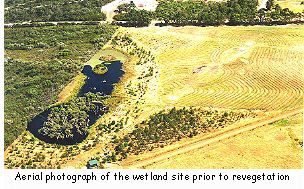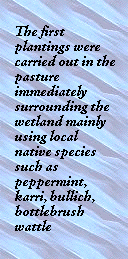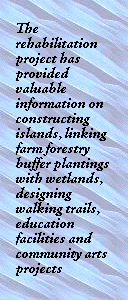
South Coast Highway, Denmark

|
Denmark Wetland Education Centre wetland restoration
South Coast Highway, Denmark |
 |
 Background
Background
During 1992 work began to restore an eight hectare patch of kikuyu pasture with remnant paperbarks situated two kilometres east of Denmark and adjacent to the South Coast Highway. The paperbarks (Melaleuca preissiana) were growing in a seasonal, shallow wetland that was surrounded by pasture and grazed by cattle as part of the Denmark Agricultural College Farm. In 1992 Basil Schur from Green Skills approached the college as there was concern about the decline of the paperbarks and the college subsequently agreed to a restoration project around the wetland. Wetland restoration
The wetland was fenced in 1992 and in 1993 a preliminary site plan for a revegetation project was formulated by Sylvia Leighton (subsequently 'Land For Wildlife' Officer, Department of Conservation and Land Management, Albany). During 1993 old fences were removed and the college commenced the site preparation which included ripping, mounding and spraying of weeds using Roundup.
The first plantings were carried out in the pasture immediately surrounding the wetland mainly using local native species such as peppermint (Agonis flexuous), karri (Eucalyptus diversicolor), bullich (E. megacarpa), bottlebrush (Callistemon and Kunzea), and wattle (Acacia saligna). The planting was successful despite problems with kangaroo grazing and competition from weeds. Also during this time two earth islands were constructed and revegetated and rock and log piles were established in the wetland for bird roosting sites. During 1994 agroforestry planting took place adjacent to the 1993 planting using fast growing eucalypts from the eastern states such as E. saligna, E. grandis and E. botryoides. An understorey of local native species was also planted, which included Acacia saligna and Melaleuca preissiana. At same time a soil map and concept plan for planting the remaining cleared area was completed by Bob Gretton ( Landcare Planning Consultant, Denmark). Planting continued until 1996 with the 1995 planting being a non-herbicide trial.
In 1999 the Shire of Denmark established a 20 metre deep bore adjacent to the wetland. The water is used to irrigate the new oval and gardens at the Denmark High School. Green Skills were concerned how the extraction of water would affect the wetland and they asked that a limit be put on who could use the water. The shire agreed and they also agreed to carry out careful monitoring of how much water was extracted. Basil explained that it would be difficult to judge how the bore is affecting the wetland because of seasonal and annual differences in rainfall and runoff. In addition there have been many changes to the catchment area with revegetation. It is also a perched wetland and the bore is extracting water from a deeper level. Visual monitoring will be carried out over the years to come in addition to shallow watertable monitoring.
Basil explained that in hindsight the botanical survey of the adjoining bushland would have been done earlier and a greater effort would have been made to use local provenance species in the area immediately around the wetland. This would have been better ecologically than using native species from further afield and elsewhere in the southwest. Green Skills haven't carried out any water quality monitoring, but the site is now part of a regional water monitoring project by the Department of Environment. It is too early in the project to tell if there has been an improvement in water quality. However, Basil believes that it is working better as a nutrient stripping basin now because of the increase in fringing vegetation. In previous years the wetland has suffered an infestation of azolla (Azolla filiculoides) and Basil noticed that it was less prevalent in 2000, which may indicate a change in water quality. The rehabilitation project has provided valuable information on constructing islands, linking farm forestry buffer plantings with wetlands, designing walking trails, education facilities and community arts projects. It is also an example of a successful method of linking demonstration wetland sites with broader educational and cultural objectives. Green Skills have been actively managing the seven hectare farm forestry section by thinning and pruning. "So the message that we'd like to put out is that forestry plantings within a wetland buffer area need to be managed and looked after if they are to be of productive use to landholders". The wetland site now houses a Training and Education Centre for Green Skills. The wetland centre was designed and is managed to be low maintenance and it is a good example of a low cost centre. The project also highlighted the challenges of liaising with other people who have a role in wetland management. Basil explained that: "There are a lot of factors other than environmental that affect the success of a wetland project". Denmark Agricultural College Wetland catchment statistics
|
||||||||||||
 |
|||||||||||||
 |
|||||||||||||